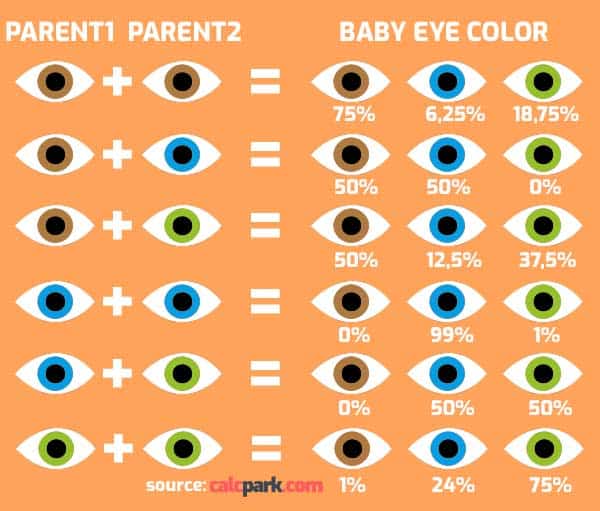Would you like to know what colour your future child’s eyes will be? Our Baby Eye Colour Calculator tells you within a second.
Baby Eye Color Calculator
Baby Eye Colour Calculator: some tips and useful information
1. How does the Eye Colour Calculator work?
Simply enter the eye colour of both parents, and then click on the "Calculate" button of the Eye Colour Calculator. Then the calculator will tell you what eye colour your future child will most likely have.
2. How does the Eye Colour Calculator predict the eye colour of the unborn child?
Our Eye Colour Calculator uses the results of the most recent genetic studies to predict the eye colour of your future child. Although there are still many open questions concerning this topic, the eye colours of the parents are enough in many cases to predict the eye colour of their future child with high probability.
3. Which eye colours are possible?
The following eye colours – listed in the order of their frequency – are possible:
- Brown: This is the most common eye colour in Europe, Asia, Africa and the Americas. The brown colour is caused by a high concentration of melanin. Genetic studies found that brown eyes are extremely dominant, and this fact is also reflected in the combinations calculated by the Eye Colour Calculator.
- Blue: Blue eyes are much rarer than brown eyes. This colour is caused by a gene mutation that does nothing else than changing the scattering of light. It is believed that all blue-eyed persons have one common ancestor. In some regions, blue eye colour is more common than brown. In Scandinavia, for example, 80 per cent of the population has blue eyes (and blond hair).
- Green: Green eye colour is even rarer than the blue one. In some nations it is so rare that special characteristics are associated with this eye colour. Only 2 per cent of the world’s population has green eyes – that means 1 in 50 people.
- Grey: Grey eyes are a variation of blue eyes. This colour is also caused by a gene mutation that changes the scattering of light. Together with a bit larger deposits of collagen, it results in a greyish colour.
- Amber / golden: Amber eyes are basically a subvariety of brown eyes. This special hue is caused by the deposits of the yellow pigment called lipochrome in the iris. This colour is also referred to as golden.
- Albino (red): This eye colour appears if melanin is missing from the eyes. In this case eyes are red, owing to the small blood vessels that become dominant. Albinism, by the way, is not curable, but proper protection is important: eyes must be protected from bright light and sunlight. Fortunately, this condition is very rare; it has a prevalence rate of 1:50,000.
3. Babies have bluish-grey eyes. How is it possible?
Newborn babies most commonly have blue or bluish-grey eyes. This colour may remain unchanged for half a year or a year, but by the 1st birthday of the baby, eyes will reach their final colour. It may rarely happen that the eye colour remains unchanged up until the 3rd birthday. The Eye Colour Calculator predicts this colour.
4. How is the eye colour inherited? Is this the thing that is calculated by the Baby Eye Colour Calculator?
The eye colour of a baby is partly determined by the genetic code of the parents – it is basically 1 gene from each parent. Our Eye Colour Calculator uses the most recent studies to calculate with the combinations listed below.
| FATHER’S EYE COLOUR | MOTHER’S EYE COLOUR | BABY’S EYE COLOUR |
| brown | brown | brown (75%), green (18,75%), blue (6,25%) |
| brown | blue | brown (50%), blue (50%) |
| blue | brown | brown (50%), blue (50%) |
| brown | green | brown (50%), green (37,5%), blue (12,5%) |
| green | brown | brown (50%), green (37,5%), blue (12,5%) |
| blue | blue | blue (99%), green (1%) |
| blue | green | blue (50%), green (50%) |
| green | blue | blue (50%), green (50%) |
| green | green | green (75%), blue (24%), brown (1%) |
5. The genetics of eye colour
The picture below provides a clear overview of the genetics of eye colour and explains how genes determine the eye colour of the future child. By the way, based on the characteristics of the parents, not only the colour of the baby’s eyes but also his/her potential blood type can be determined before birth. If you would like to know more, use our Blood Type Calculator application on CalcPark.com.
 Source: Baby Eye Colour Calculator – CalcPark.com
Source: Baby Eye Colour Calculator – CalcPark.com 6. Is it possible to have two different-coloured eyes?
Yes, it is. It is caused by the so-called Waardenburg syndrome, a very rare genetic condition. In this case, someone may have two different-coloured eyes. Moreover, sometimes it is possible to have multiple colours, for example green and blue, within one eye. This latter condition is called sectoral heterochromia iridum.
7. I would like to change my eye colour. Is it possible?
Yes, it is. The easiest solution is provided by contact lenses which refract the light in a way that results in the eye colour you wish to have. There is, however, a more longer-lasting solution, as well. At a clinic in California a surgical procedure was developed that “changes” the colour of eyes from brown to blue. With this procedure a new, artificial iris is created, and an incision is made to place this new iris into the eye. The surgery only takes 15 minutes, and it is reversible.
